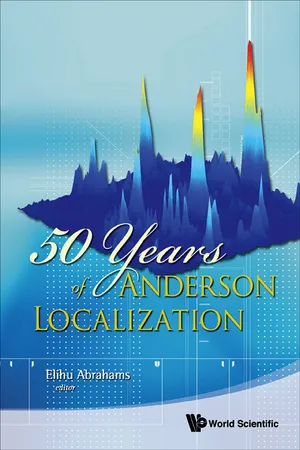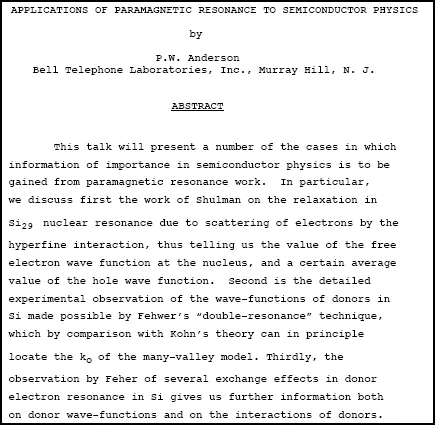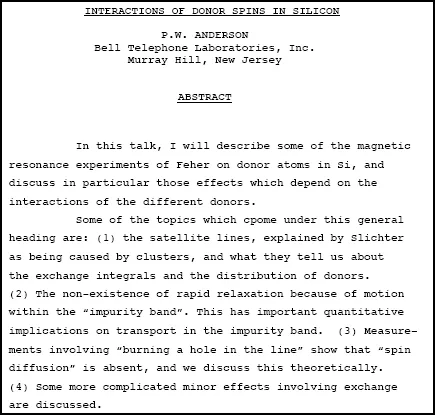
- 612 pages
- English
- ePUB (mobile friendly)
- Available on iOS & Android
50 Years of Anderson Localization
About This Book
In his groundbreaking paper “Absence of diffusion in certain random lattices (1958)”, Philip W Anderson originated, described and developed the physical principles underlying the phenomenon of the localization of quantum objects due to disorder. Anderson's 1977 Nobel Prize citation featured that paper, which was fundamental for many subsequent developments in condensed matter physics and technical applications. After more than a half century, the subject continues to be of fundamental importance. In particular, in the last 25 years, the phenomenon of localization has proved to be crucial for the understanding of the quantum Hall effect, mesoscopic fluctuations in small conductors, some aspects of quantum chaotic behavior, and the localization and collective modes of electromagnetic and matter waves.
This unique and invaluable volume celebrates the five decades of the impact of Anderson localization on modern physics. In addition to the historical perspective on its origin, the volume provides a comprehensive description of the experimental and theoretical aspects of Anderson localization, together with its application in various areas, which include disordered metals and the metal–insulator transition, mesoscopic physics, classical systems and light, strongly-correlated systems, and mathematical models.
The volume is edited by E Abrahams, who has been a contributor in the field of localization. A distinguished group of experts, each of whom has left his mark on the developments of this fascinating theory, contribute their personal insights in this volume. They are: A Amir (Weizmann Institute of Science), P W Anderson (Princeton University), G Bergmann (University of Southern California), M Büttiker (University of Geneva), K Byczuk (University of Warsaw & University of Augsburg), J Cardy (University of Oxford), S Chakravarty (University of California, Los Angeles), V Dobrosavljević (Florida State University), R C Dynes (University of California, San Diego), K B Efetov (Ruhr University Bochum), F Evers (Karlsruhe Institute of Technology), A M Finkel'stein (Weizmann Institute of Science & Texas A&M University), A Genack (Queens College, CUNY), N Giordano (Purdue University), I V Gornyi (Karlsruhe Institute of Technology), W Hofstetter (Goethe University Frankfurt), Y Imry (Weizmann Institute of Science), B Kramer (Jacobs University Bremen), S V Kravchenko (Northeastern University), A MacKinnon (Imperial College London), A D Mirlin (Karlsruhe Institute of Technology), M Moskalets (NTU “Kharkiv Polytechnic Institute”), T Ohtsuki (Sophia University), P M Ostrovsky (Karlsruhe Institute of Technology), A M M Pruisken (University of Amsterdam), T V Ramakrishnan (Indian Institute of Science), M P Sarachik (City College, CUNY), K Slevin (Osaka University), T Spencer (Institute for Advanced Study, Princeton), D J Thouless (University of Washington), D Vollhardt (University of Augsburg), J Wang (Queens College, CUNY), F J Wegner (Ruprecht-Karls-University) and P Wölfle (Karlsruhe Institute of Technology).
Contents:
- Thoughts on Localization (P W Anderson)
- Anderson Localization in the Seventies and Beyond (D Thouless)
- Intrinsic Electron Localization in Manganites (T V Ramakrishnan)
- Self-Consistent Theory of Anderson Localization: General Formalism and Applications (P Wölfle & D Vollhardt)
- Anderson Localization and Supersymmetry (K B Efetov)
- Anderson Transitions: Criticality, Symmetries and Topologies (A D Mirlin et al.)
- Scaling of von Neumann Entropy at the Anderson Transition (S Chakravarty)
- From Anderson Localization to Mesoscopic Physics (M Büttiker & M Moskalets)
- The Localization Transition at Finite Temperatures: Electric and Thermal Transport (Y Imry & A Amir)
- Localization and the Metal–Insulator Transition — Experimental Observations (R C Dynes)
- Weak Localization and Its Applications as an Experimental Tool (G Bergmann)
- Weak Localization and Electron–Electron Interaction Effects in Thin Metal Wires and Films (N Giordano)
- Inhomogeneous Fixed Point Ensembles Revisited (F J Wegner)
- Quantum Network Models and Classical Localization Problems (J Cardy)
- Mathematical Aspects of Anderson Localization (T Spencer)
- Finite Size Scaling Analysis of the Anderson Transition (B Kramer et al.)
- A Metal–Insulator Transition in 2D: Established Facts and Open Questions (S V Kravchenko & M P Sarachik)
- Disordered Electron Liquid with Interactions (A M Finkel'stein)
- Typical-Medium Theory of Mott–Anderson Localization (V Dobrosavljević)
- Anderson Localization vs. Mott–Hubbard Metal–Insulator Transition in Disordered, Interacting Lattice Fermion Systems (K Byczuk et al.)
- Topological Principles in the Theory of Anderson Localization (A M M Pruisken)
- Speckle Statistics in the Photon Localization Transition (A Z Genack & J Wang)
Readership: Graduate students and professionals in condensed matter physics.
Frequently asked questions
Information
Chapter 1
THOUGHTS ON LOCALIZATION



Chapter 2
ANDERSON LOCALIZATION IN THE SEVENTIES AND BEYOND
Table of contents
- Cover Page
- Title Page
- Copyright Page
- Preface
- Contents
- Chapter 1: Thoughts on Localization
- Chapter 2: Anderson Localization in the Seventies and Beyond
- Chapter 3: Intrinsic Electron Localization in Manganites
- Chapter 4: Self-Consistent Theory of Anderson Localization: General Formalism and Applications
- Chapter 5: Anderson Localization and Supersymmetry
- Chapter 6: Anderson Transitions: Criticality, Symmetries and Topologies
- Chapter 7: Scaling of von Neumann Entropy at the Anderson Transition
- Chapter 8: From Anderson Localization to Mesoscopic Physics
- Chapter 9: The Localization Transition at Finite Temperatures: Electric and Thermal Transport
- Chapter 10: Localization and the Metal–Insulator Transition — Experimental Observations
- Chapter 11: Weak Localization and its Applications as an Experimental Tool
- Chapter 12: Weak Localization and Electron–Electron Interaction Effects in thin Metal Wires and Films
- Chapter 13: Inhomogeneous Fixed Point Ensembles Revisited
- Chapter 14: Quantum Network Models and Classical Localization Problems
- Chapter 15: Mathematical Aspects of Anderson Localization
- Chapter 16: Finite Size Scaling Analysis of the Anderson Transition
- Chapter 17: A Metal–Insulator Transition in 2D: Established Facts and Open Questions
- Chapter 18: Disordered Electron Liquid with Interactions
- Chapter 19: Typical-Medium Theory of Mott–Anderson Localization
- Chapter 20: Anderson Localization vs. Mott–Hubbard Metal–Insulator Transition in Disordered, Interacting Lattice Fermion Systems
- Chapter 21: Topological Principles in the Theory of Anderson Localization
- Chapter 22: Speckle Statistics in the Photon Localization Transition